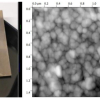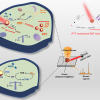
Researchers from Purdue University in the USA have created a new imaging technology based on Raman spectroscopy that reveals subtle changes in breast tissue, representing a potential tool to determine a woman's risk of developing breast cancer and to study ways of preventing the disease.
The researchers used a special “3-D culture” that mimics living mammary gland tissue, and also showed that a fatty acid found in some foods influences this early precancerous stage. Unlike conventional cell cultures, which are flat, the 3-D cultures have the round shape of milk-producing glands and behave like real tissue, said Sophie Lelièvre. Researchers are studying changes that take place in epithelial cells, which make up tissues and organs where 90% of cancers occur. The changes in breast tissue are thought to be necessary for tumours to form, she said.
“By mimicking the early stage conducive to tumours and using a new imaging tool, our goal is to be able to measure this change and then take steps to prevent it,” Lelièvre said.
The new imaging technique, called vibrational spectral microscopy, is based on Raman. By monitoring the same 3-D culture before and after exposure to certain risk factors, the new method enables researchers to detect subtle changes in single live cells.
Findings are detailed in a research paper in the Biophysical Journal (doi: 10.1016/j.bpj.2012.01.023). The paper was written by doctoral students Shuhua Yue, Juan Manuel Cárdenas-Mora, and Lesley S. Chaboub, Lelièvre and Ji-Xin Cheng.
“This work shows the importance of engineering for the development of primary prevention research in breast cancer,” said Yue, a biomedical engineering. The research is part of the International Breast Cancer and Nutrition (IBCN) project launched by Purdue in October 2010 to better understand the role nutrients and other environmental factors play in breast tissue alterations and cancer development.
Researchers studied live tissue in a culture that reproduces the mammary epithelium. “This extremely sensitive technique shows the harmful impact of a nutrient called arachidonic acid,” said Lelièvre. “This fatty acid has been previously proposed to increase breast cancer risk, but until now there was no biological evidence of what it could do to alter breast epithelial cells.” The imaging method detects changes in the “basoapical polarity” of epithelial tissues. Specific proteins and other biochemical compounds called lipids are normally located in one of two regions, called the basal and apical membranes. Because only certain proteins and lipids are found in basal membranes, while others are located only in apical membranes, the cells are said to be polarized.
“This polarity is critical for the proper structure and function of tissue,” Lelièvre said. “What we have shown previously is that when polarity is altered, tissue that otherwise looks normal can be pushed into a cell cycle necessary to form a tumour. It’s the earliest change in the epithelial tissue that puts the cells at risk to form a tumour. Now, thanks to the vibrational spectral microscopy technique developed by Dr Cheng, we can measure apical polarity status in live tissues and real time.”
The findings could lead to a method for preventing tumour formation by restoring the proper polarity.
“We are mimicking formation of breast epithelium as it is normally polarised, and we can play with it and make it lose apical polarity on demand,” Lelièvre said. “Then we can mimic an early change thought to be conducive to tumour development.”
The researchers aim to use the imaging technology on live 3-D cultures of non-cancerous breast tissue to screen for protective and risk factors for breast cancer the same way that tumours are used now in cultures to screen for drugs that can be used for treatment.
“Now there is no good way to assess risk for breast cancer,” Lelièvre said. “Assessments are mainly based on family history and genetic changes, and this only accounts for a very small percentage of women who get breast cancer. We need technologies to assess the risk better and then screen for protective factors that could be used on individual patients because not everybody will be responsive to the same factors.”
An immediate application of the technique is a way to study cell lines created from tissue taken from women at different risk levels, screening for factors that could restore full polarity in the breast tissue to prevent tumour formation.
“The state of the art is to take tumour cells, put them in a 3-D culture where they form tumours, and then test drugs on these tumours,” Lelièvre said. “What we want to do now is the same thing but for preventive strategies using a normal tissue.”
In a collaboration with researchers at Indiana University–Purdue University Indianapolis, the team plans to study cell lines from women who are at different risk levels.
The new imaging tool was needed because conventional live cell imaging methods are designed for flat cell cultures. Mimicking tissue polarity requires a 3-D culture to form the mammary gland structures at the end of the breast ducts. The structures resemble tiny balls about 30 µm in diameter and contain about 35 cells.
Cheng said his lab will continue to develop a “hyperspectral” imaging system capable of not only imaging a specific point in a culture but also many locations to form a point-by-point map so that tissue polarity can be directly visualised.














